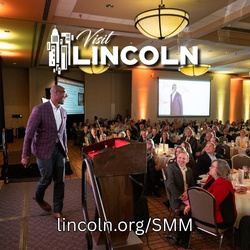Sponsored Content
If you want to understand Wichita, Kansas, the Wichita-Sedgwick Historical Museum is a good place to start. Within the walls of the old City Hall, a regal 1892 stone edifice, a collection of 70,000 artifacts helps show how a rough-and-tumble Midwest outpost became a nationally known leader in aviation, agriculture and education.
As the museum points out, creating this city in what it calls “the great American Desert,” took “courage, ingenuity and entrepreneurial spirit.”
All three are still abundant in this metro area of 640,000, which can make Kansas’s largest city an inspiring meeting place.
Here’s a look at Wichita’s major economic drivers and how they enrich meetings and conferences.
Aviation
Wichita’s aviation industry took flight when George Cessna brought his company to town in the 1920s. Beechcraft, Stearman, Laird and other aircraft makers soon followed, and in a few short years, Wichita became known as “The Air Capital of the World.” It continues to live up to that billing. Home to more than 450 aerospace companies, Wichita has the country’s third-largest concentration of aviation workers. Since 1929, it has delivered 35% of all general aviation aircraft made in this country, more than any other city.
It’s impossible to miss aviation’s influence, beginning with arrival at Dwight D. Eisenhower National Airport, where three-dimensional displays illustrate the industry’s impact. As fitting for a place where flight rules, Wichita’s airport earns accolades, landing in 2024 on Newsweek’s list of top 10 small airports.
Along city streets where 100 murals splash across brick walls, visitors spot several with aviation themes — a massive plane in one; birds in flight reminding to “Fly In for Fun,” in another.
Several hotels have fun using aviation as inspiration for their décor, including the historic Hotel at Old Town, where aviation relics, photos and art enliven the Aviation Floor. At Scotch and Sirloin, a longtime favorite known for its steaks, walls in three private dining rooms mimic the side of a passenger plane.
Aviation-related attractions double as off-site venues. Wichita’s original 1935 art deco-style airport terminal houses the Kansas Aviation Museum, where exhibits include Women in Aviation and a 1920 Laird Swallow, the first production aircraft built in the city. A climb up the old control tower provides a 360-dgree view from one of the city’s highest points.
For events with military or aviation ties, the B-29 Doc Hangar, Education and Visitors Center at Eisenhower National Airport is a favorite. The centerpiece for events in this 42,000-square-foot hangar is Doc, one of only two remaining, airworthy Boeing Superfortresses. For a fun treat, visitors can purchase a ride on the plane — a 30-minute flight for up to nine passengers.
At Exploration Place, a science center that engages those of all ages, the Design Build Fly exhibit is all about making aircraft. Visitors can design an airplane seat, test landing gear or rivet a plane’s wing. The center is also a beloved event space. Its 3,000-square-foot Waterway Hall needs little embellishment with its views of the Arkansas River through glass walls or from the adjoining shaded terrace. There’s also a boardroom, classrooms and the state’s largest 360-degree theater.
Agriculture
To say Kansas is big in terms of agriculture is an understatement. An estimated 88% of the state’s land is in agricultural production, and when it comes to producing cattle and calves, wheat, corn, soybeans and even sunflowers, Kansas is always at or near the top.
In the 1800s, Wichita was the end of the road for cattle drives, and later, the state’s fertile lands and the crops they produced grew the agricultural economy even more. New businesses arrived to support farmers and education stepped up to put focus on agriculture and research. The intent focus on the industry also attracted agriculture-related corporations, including Cargill. It’s hard to miss that company’s in downtown Wichita, where its Protein Division is headquartered in a $70 million building.
Groups that want to step back to the days when the cattle and cowboys first thundered into town might want to plan an evening event at Old Cowtown Museum, where restored log houses and other buildings re-create an 1865 community. A small crowd could have sarsaparillas in Fritz Snitzler’s Saloon, or a larger one could have a reception in the modern visitor’s center’s great room, with its stone fireplace and adjoining patio.
And, although Wichita is definitely urban, agritourism adventures are in and all around it. A downtown parking garage is home to Rise Farms, a 15,000-square-foot urban garden and solar farm. The produce the farm grows supplies both residents and area restaurants as it diminishes the urban heat island effect, prevents excess stormwater run-off and makes the building more energy efficient. Tours of the farm are offered during the growing season, so that people can learn more about growing fruits and vegetables without using manmade chemicals to diminish weeds and bugs.
Firefly Farm, an active partner in Rise Farms, is another off-site experience. The five-acre farm, one mile from the city limits, is known for its heirloom vegetables and it has hosted a number of farm-to-table dinners and private parties and events.
About 30 minutes north of Wichita, wine tastings in a small wine cellar or an event center with vineyard views at Grace Hill Winery are a way to enjoy the Kansas countryside. A sunny patio is a warm weather option. Fifteen minutes from town, Elderslie Farms is known for bountiful farm-to-table dinners. It welcomes private dinners and receptions in a restored farmhouse or a roomy patio with a covered pavilion.
Education
Complex industries require expertise, innovation and training, and Wichita’s education systems support not just aviation and agriculture, but all business sectors that impact the Kansas economy. Wichita State University’s National Institute for Aviation Research and the National Center for Aviation Training graduates about 1,500 students a year who have the skills needed for advanced manufacturing in the aerospace and general manufacturing areas. Nearly a dozen companies and organizations make their home at Wichita State’s Innovation Campus, which creates real-world work experiences for students. Access to these schools and others including WSU Tech, the Kansas Health Science Center and the National Institute for Aviation Research make it possible for conferences and meetings to include top-rated speakers and tours of state-of-the-art facilities in their itineraries. At Wichita State’s main campus, talks and tours involving entrepreneurism, can use the world’s first Pizza Hut as inspiration. The restaurant was moved to campus and is now a museum that tells the story of two Wichita State students who grew their pizza concept into one of the largest pizza restaurant chains in the world.
For more information:
Visit Wichita
316-265-2800











